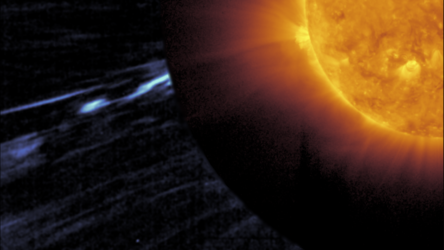Accept all cookies Accept only essential cookies See our Cookie Notice

About ESA
The European Space Agency (ESA) is Europe’s gateway to space. Its mission is to shape the development of Europe’s space capability and ensure that investment in space continues to deliver benefits to the citizens of Europe and the world.
Highlights
ESA - United space in Europe
This is ESA ESA facts Member States & Cooperating States Funding Director General Top management For Member State Delegations European vision European Space Policy ESA & EU Space Councils Responsibility & Sustainability Annual Report Calendar of meetings Corporate newsEstablishments & sites
ESA Headquarters ESA ESTEC ESA ESOC ESA ESRIN ESA EAC ESA ESAC Europe's Spaceport ESA ESEC ESA ECSAT Brussels Office Washington OfficeWorking with ESA
Business with ESA ESA Commercialisation Gateway Law at ESA Careers Cyber resilience at ESA IT at ESA Newsroom Partnerships Merchandising Licence Education Open Space Innovation Platform Integrity and Reporting Administrative Tribunal Health and SafetyMore about ESA
History ESA Historical Archives Exhibitions Publications Art & Culture ESA Merchandise Kids Diversity ESA Brand CentreLatest
Space in Member States
Find out more about space activities in our 23 Member States, and understand how ESA works together with their national agencies, institutions and organisations.
Science & Exploration
Exploring our Solar System and unlocking the secrets of the Universe
Go to topicAstronauts
Missions
Juice Euclid Webb Solar Orbiter BepiColombo Gaia ExoMars Cheops Exoplanet missions More missionsActivities
International Space Station Orion service module Gateway Concordia Caves & Pangaea BenefitsLatest
Space Safety
Protecting life and infrastructure on Earth and in orbit
Go to topicAsteroids
Asteroids and Planetary Defence Asteroid danger explained Flyeye telescope: asteroid detection Hera mission: asteroid deflection Near-Earth Object Coordination CentreSpace junk
About space debris Space debris by the numbers Space Environment Report In space refuelling, refurbishing and removingSafety from space
Clean Space ecodesign Zero Debris Technologies Space for Earth Supporting Sustainable DevelopmentLatest
Applications
Using space to benefit citizens and meet future challenges on Earth
Go to topicObserving the Earth
Observing the Earth Future EO Copernicus Meteorology Space for our climate Satellite missionsCommercialisation
ESA Commercialisation Gateway Open Space Innovation Platform Business Incubation ESA Space SolutionsLatest
Enabling & Support
Making space accessible and developing the technologies for the future
Go to topicBuilding missions
Space Engineering and Technology Test centre Laboratories Concurrent Design Facility Preparing for the future Shaping the Future Discovery and Preparation Advanced Concepts TeamSpace transportation
Space Transportation Ariane Vega Space Rider Future space transportation Boost! Europe's Spaceport Launches from Europe's Spaceport from 2012Latest
Tracking space weather
Thank you for liking
You have already liked this page, you can only like it once!
In early March 2022, the ESA/NASA Solar Orbiter spacecraft got a feel for how a future space weather forecasting system might work. On 10 March, a solar flare produced a coronal mass ejection (CME) that was directed at Earth. The cameras on the ESA/NASA mission SOHO (Solar and Heliospheric Observer) recorded the event at around 22:06 UT. Solar Orbiter also observed it from its viewpoint about 67 million km from the Sun.
Late on 11 March, the CME arrived at Solar Orbiter’s position to be detected by the magnetometer (MAG). The readings could be used to calculate the time the CME would strike Earth’s magnetic field and the possible severity of the CME’s effects when it did. Solar Orbiter’s Solar Wind Analyser (SWA) instrument also recorded the event as a change in properties of the solar wind.
On 13 March, the lumbering CME finally passed over several spacecraft, including NASA’s Wind, stationed at the L1 point, which is 99% of the Earth’s distance from the Sun, about 1.5 million km from Earth. About an hour later, the CME struck Earth and sparked aurorae in the skies of Earth.
Thanks to the data from Solar Orbiter MAG, Christian Möstl, Space Research Institute, Austrian Academy of Sciences, Austria, had been able to predict the aurora. He posted a prediction on social media on 12 March 18:26 UT. This was seen by J Bant Sexson IV, who set up cameras at Eklutna Lake near Anchorage, Alaska. At around 5 am local time on the morning of 13 March, as twilight was starting to creep into the sky, he was rewarded with a brief but exciting display of the northern lights, that he posted to social media.
-
CREDIT
Central Sun image: ESA & NASA/Solar Orbiter/EUI team; corona imagery: SOHO (ESA & NASA); Solar Orbiter data: ESA & NASA/Solar Orbiter/MAG & SWA Teams; Wind data: NASA/GSFC/Wind Aurora: J Bant Sexson IV -
LICENCE
ESA Standard Licence

Zooming in on a solar switchback

Solar Orbiter observes an active patch of the Sun

Solar Orbiter observes an active region on the Sun

Capturing a solar switchback















 Germany
Germany
 Austria
Austria
 Belgium
Belgium
 Denmark
Denmark
 Spain
Spain
 Estonia
Estonia
 Finland
Finland
 France
France
 Greece
Greece
 Hungary
Hungary
 Ireland
Ireland
 Italy
Italy
 Luxembourg
Luxembourg
 Norway
Norway
 The Netherlands
The Netherlands
 Poland
Poland
 Portugal
Portugal
 Czechia
Czechia
 Romania
Romania
 United Kingdom
United Kingdom
 Slovenia
Slovenia
 Sweden
Sweden
 Switzerland
Switzerland
























